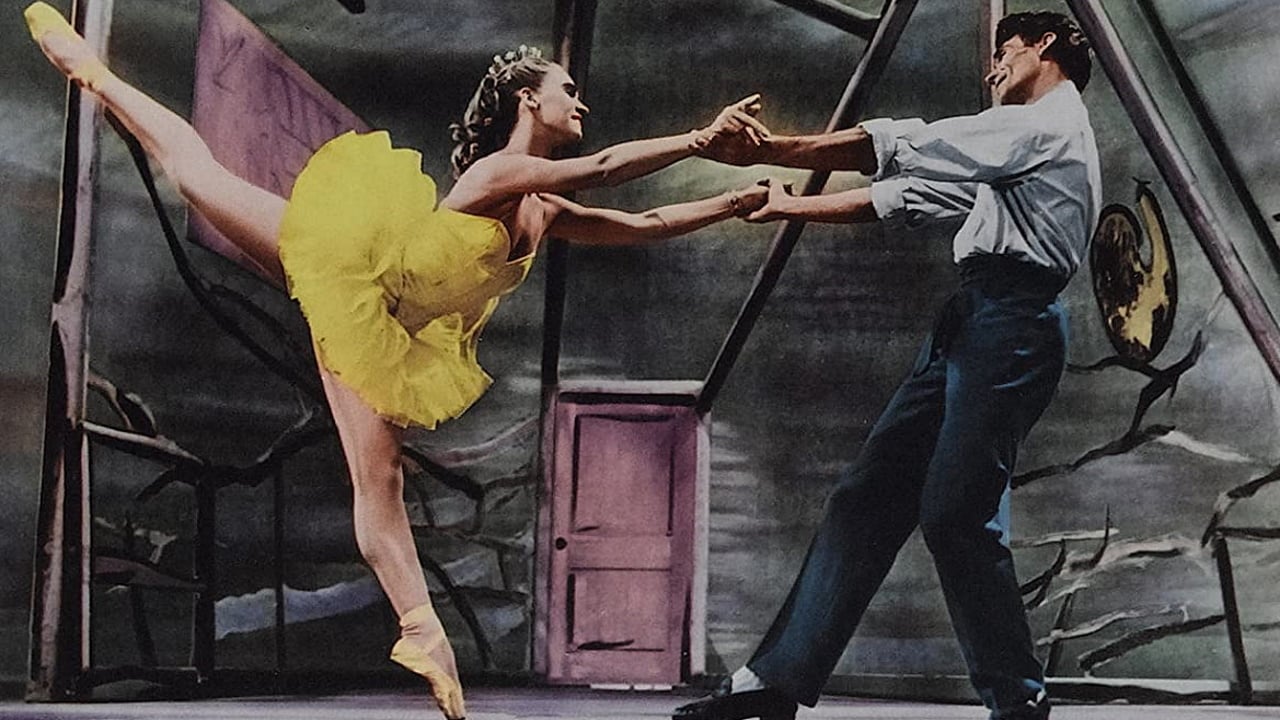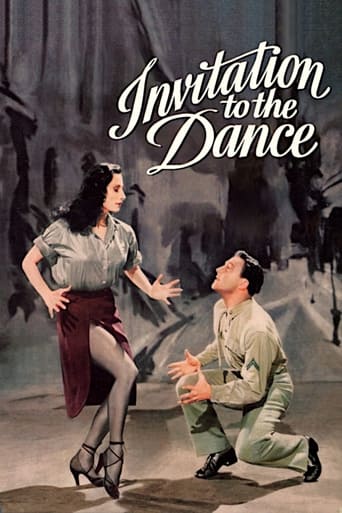

Invitation to the Dance is what you get when you take an artist at the peak of his abilities and allow his imagination to run wild. Gene Kelly--and some very talented people in all fields--integrated music and dance to create three distinct stories.He reduces some scenes to their visual essences by using abstract or minimalist sets, aided by lighting effects. The third story includes cartoons, allowing Kelly to take his imagination beyond the bounds of human limitations and physics.The performances are a synthesis of various dance and related forms (ballet, tap, jazz, mime, acrobatics, pop, and ethnic) with musical accompaniment (classical, jazz--cool and hot--ethnic, and pop).Invitation to the Dance is a treat for any dance lover. It should be seen by all young students of dance.It would be interesting to see this film they way Kelly originally imagined it, with him dancing in one section only.
... View MoreThe first two segments of this film may or may not impress you, but do watch the third: "Sinbad the Sailor". Kelly plays an American sailor in an exotic Oriental market. He rubs an old lamp and a genie appears, played by an amazingly talented kid. After a bit of messing around,the genie gets a sailor suit, too. Then they open a book to a picture of a wonderous land. The genie transports them inside and all the rest features the two dancers (mostly Kelly alone) dancing with animation.This segment is much longer than any other live-plus-animation sequence until Mary Poppins excepting, possibly Song of the South whose sequences were nowhere near so complex as this. Kelly dances with an animated dragon (that wraps around him), into a harem, is chased by the Sultan's guards, has a long sequence with one harem girl, and then a very long sequence with the guards. This is amazing work for 1952, especially when you remember that every bit of the animation is hand-painted on cels. Hanna-Barbera (then with MGM doing Tom and Jerry directed the animation. (Kelly also did a famous dance number with Jerry in Anchors Aweigh eight years earlier.) Walt Disney advised. This is swell stuff and any fan of animation should give it a look.
... View MoreI've never seen another movie quite like this classic of kitsch. Gene Kelly was behind the whole project. He was riding high at the time and MGM more or less gave him his head, but they demurred when it seemed to them that Kelly was working on some kind of Wagnerian Gesamtkunstwerk -- too highbrow for audiences.The Moguls were half right. It's somewhat too highbrow and somewhat too lowbrow. It comes out something like "Dance For The Millions" or "A Dummy's Introduction To Dance." It has nothing to do with the talent on display. It was never Kelly's intention to appear in all of the sequences. That was only as the studio's insistence. Kelly used the best available performers. In the first of the three stories -- Circus, Ring Around the Rosy, and Sinbad the Sailor -- Kelly wisely leaves the ballet sequences to Igor Youskevitch and Claire Sombert, while he limits himself mostly to mime. You know, though, Youskevitch makes those leaps look harder than they are. I studied dance myself in college and found I had an undiscovered talent -- a gift almost -- for doing jetees and then falling flat on the floor, even without the battement. Big show off, Youskevitch.The second sequence is a familiar story of an object being passed from one lover to another until it is returned to the original owner. Fun is made of the adolescent craze for a crooner who resembles Frank Sinatra in the 40s, only is voice is that of a trombone. Had Kelly tried anything daring with Tamara Toumenova, he would have been out of his league. He came to dance from athletics and sports like hockey, not from ballroom or ballet. But Kelly had courage. Some of his cast could do both acrobatics and ballet, like Tommy Rall, who plays the sharpie.The third is the most elaborate sequence, a sort of Arabian nights tale with music adapted from Rimsky-Korsakov. Kelly acquires one of those annoying little boys as a genie. Then he gets an animated fairy princess, the animation being built by the cartoonists around the real figure of Carol Haney, a fine dancer whose heft I would have preferred. I wonder how this sequence, which gets a little silly, would have gone over had the technology of, say, "Avatar" been available at the time.The chief problem here, as with some otherwise good musicals, is that the book is pedestrian. A complex and multi-faceted story with some comic interludes can be successful, as "An American In Paris" was. Better yet, make it essentially a comedy with a little edge and lots of jokes and funny moments -- "Singin' In The Rain" or "The Bandwagon." None of these three sequences has a narrative that draws us in. We are wowed by the art direction, the set dressing, the wardrobe, the flashy music, the sight of people yakking in accelerated motion, the vision of Kelly doing a threesome with Arab guards or floating in slow motion through a cloud of rubescent leaves.Too bad it's not more successful. Being a good dancer is terribly hard work. You need to start at a very early age, practice all your life, and have the coordination of a middleweight boxer. (Ask Ron Reagan, Jr.) So you put your heart and soul into it -- then you have to find a job. You might as well adopt Michael Jordan as a role model.
... View Morethis was Kelly's pet project- a film with dance, and only dance. No dialogue, only mime, movement and music. However to his disappointment, MGM shelved its release and when it was the film was released badly- it was too arty farty to be popular with the audiences at that time. Well, I love this film. It's adventurous and interesting, and it's worth a watch to appreciate all the work Kelly's put into this work, which showcases some of the greatest dancers across many styles. So go watch this under-rated film and you will be in awe of all the talent shown before your eyes!
... View More